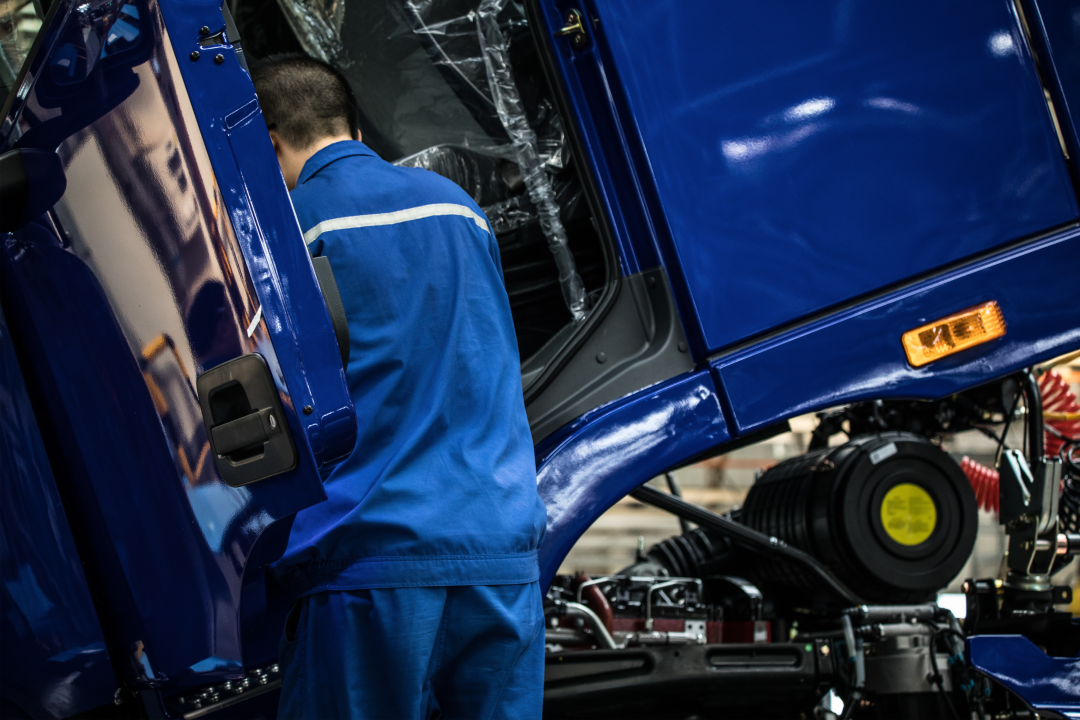
Susie Jones
Camionagii cu handicap - ce sprijin este disponibil?
Creat: 12.08.2024
•
Actualizat: 12.08.2024
În Regatul Unit, 23% din populația în vârstă de muncă a raportat că are un handicap - fără ca mulți să știe, o bună parte dintre aceștia sunt șoferi de camion care traversează la nesfârșit Europa pentru a vă livra mărfurile. În ciuda faptului că se confruntă cu multe provocări, prezența lor în comunitatea camioanelor subliniază importanța incluziunii și a diversității în industrie.
Dacă am un handicap, pot să conduc un camion?
Dacă aveți un handicap fizic sau cognitiv, puteți conduce un vehicul greu de marfă. Cu toate acestea, trebuie să treceți un examen medical pentru a determina dacă sunteți suficient de apt. Un examen medical constă în următoarele:
O discuție cu un medic cu privire la sănătatea dumneavoastră: Șoferii trebuie să fie sinceri și deschiși.
O examinare fizică în cadrul căreia medicul dumneavoastră va verifica:
Tensiunea arterială
Inima
Viziune
Test pentru diabet
Afecțiuni neurologice
Tulburări de somn.
După completare, DVLA va decide dacă puteți conduce.
Modificări ale camionului
Pentru șoferii cu dizabilități fizice, sunt disponibile următoarele modificări:
Comenzi manuale pentru a înlocui pedalele
Ajutoare de direcție
Acceleratoare pentru piciorul stâng
Conversia ambreiajului
Harnașamente
Scaune specializate
Echipament de depozitare a scaunelor cu rotile.
În 2021, producătorul de vehicule grele MAN a adaptat patru [camioane pentru șoferi cu handicap] (https://trans.info/check-out-the-lorries-man-altered-to-accommodate-disabled-drivers-228342). Adaptările au implicat echiparea camioanelor cu o platformă de ridicare pentru ca utilizatorii de scaune cu rotile să poată accesa cu ușurință cabina - cu toate comenzile montate pe sau în jurul volanului.
Deși tehnologia și adaptările avansează în industrie, mulți șoferi cu handicap încă se confruntă cu provocări la locul de muncă.

Cu ce obstacole se confruntă șoferii de camion cu handicap?
Pentru șoferii cu dizabilități poate fi dificil să obțină un loc în industrie, chiar dacă au calificările necesare și au trecut examenul medical. Multe companii sunt reticente în a furniza un vehicul adaptat - deoarece acestea pot fi o investiție costisitoare.
Pentru șoferii dispuși să plătească pentru adaptările necesare, Andy, CEO al organizației caritabile [Globe Truckers UK] (https://www.globetruckersuk.org/), afirmă că este încă dificil să găsească un loc de muncă.
"Unele companii de transport sunt reticente în a angaja persoane cu dizabilități - acestea sunt adesea circumspecte la obstacolele cu care se confruntă șoferii în afara cabinei, de exemplu, scările și ridicarea."
David Chambers, un șofer de TIR cu handicap, a vorbit despre încercările cu care se confruntă zilnic și a solicitat ajustări rezonabile ale Legii privind egalitatea - în special după ce guvernul a cerut ca mai multe persoane care beneficiază de indemnizații de handicap să revină la muncă.
David și mulți alții se confruntă cu dificultăți în depozitele mari unde, în conformitate cu [Equality Act] (https://www.legislation.gov.uk/ukpga/2010/15/contents), depozitul nu este obligat să facă ajustări rezonabile pentru șoferii cu handicap. Din motive de siguranță, aceștia trebuie să aștepte departe de camioanele lor în timpul descărcării, ceea ce îi obligă să meargă pe jos pe distanțe lungi și să urce scări.
Ce sprijin există pentru șoferii de camion cu handicap?
Găsirea de sprijin poate fi dificilă pentru cei care suferă de leziuni sau boli care le schimbă viața. Organizația caritabilă britanică Globe Truckers a fost construită de șoferi pentru a ajuta șoferii - oferind sprijin persoanelor rănite, bolnave sau cu handicap.
"Mulți șoferi cu handicap sau răniți nu știu la cine să apeleze, deoarece există foarte puține informații pentru ei. Aici intervenim noi și le oferim sprijinul și îndrumarea noastră - fie că este vorba de a le indica persoanele potrivite sau de a le oferi finanțare pentru echipamente."
"Unii șoferi au nevoie doar de cineva cu care să vorbească, iar noi suntem aici pentru a le oferi acest sprijin în orice mod posibil. În viitor, ne-ar plăcea să putem finanța adaptări ale camioanelor pentru șoferi. Adaptările pot fi foarte costisitoare, iar majoritatea șoferilor cu handicap trebuie să plătească din propriul buzunar pentru acestea. Pentru a realiza acest lucru, avem nevoie de mai multe fonduri și de sprijin din partea celor din industrie", afirmă Andy.
Cum poate ajuta industria?
Pentru un peisaj mai incluziv și mai divers, industria trebuie să facă mai mult pentru a lua în considerare dizabilitățile fizice și cognitive - o schimbare care trebuie să aibă loc curând, spune Andy.
"Este vital ca industria să își investească sprijinul și timpul înapoi în ea însăși, fie direct către șoferii cu handicap, fie către organizații caritabile precum Globe Truckers. Industria nu se poate aștepta să facă apel la oameni dacă nu oferă sprijin minorităților."
Fiind un refugiu pentru mulți șoferi, stațiile de camioane pot deschide calea prin furnizarea de facilități accesibile. În 2022, guvernul a investit 100 de milioane de lire sterline în industrie pentru a îmbunătăți facilitățile de pe marginea drumurilor și pentru a crea parcări de camioane mai sigure.

Finanțarea guvernamentală ar putea îmbunătăți accesibilitatea pentru șoferii cu handicap la stațiile populare. Schimbări precum cele de mai jos ar putea avea un impact substanțial:
Spații de parcare accesibile scaunelor cu rotile: șoferii cărora le este greu să urce și să coboare din cabină au nevoie de spațiu suplimentar - în special pentru cei care au nevoie de un dispozitiv de ridicare.
Facilități accesibile: restaurante, toalete și alte facilități accesibile asigură un mediu incluziv.
Companiile de flote pot contribui la crearea unui mediu mai favorabil incluziunii prin punerea în aplicare a următoarelor măsuri:
Modificarea camioanelor - facilitarea manevrării pentru șoferii cu handicap prin intermediul comenzilor manuale și al tehnologiilor adaptive.
Asistență și formare - oferirea de cursuri pentru a aborda provocări sau nevoi specifice.
Practici de angajare incluzive - adoptarea unei abordări imparțiale la angajare promovează o cultură incluzivă și diversă.
Asigurarea unei culturi diverse și favorabile incluziunii este vitală pentru a atrage mai mulți șoferi în industria transporturilor. Sprijinul pentru cei cu dizabilități fizice și cognitive a fost neglijat de industrie - lăsând mulți șoferi nesiguri la cine să apeleze. Șoferii cu handicap oferă un punct de vedere unic și o adaptabilitate care reprezintă o schimbare binevenită pentru industrie
Ce trebuie să faceți dacă deveniți invalid în timpul carierei?
Dacă dezvoltați o afecțiune medicală sau un handicap "notificabil", trebuie să anunțați DVLA - DVLA va face următoarele:
Decideți prin scrisoare - unele circumstanțe pot necesita mai multe informații.
Evaluați starea dumneavoastră medicală și decideți rezultatul.
Dacă trebuie să vă adaptați vehiculul, veți avea nevoie de o evaluare independentă a [adaptărilor.] (https://www.drivingmobility.org.uk/)
Dacă trebuie să vă opriți din condus, DVLA vă va oferi un motiv medical.



